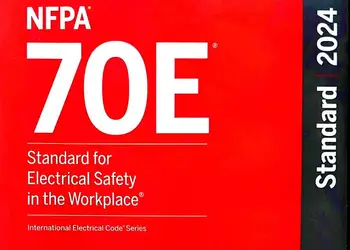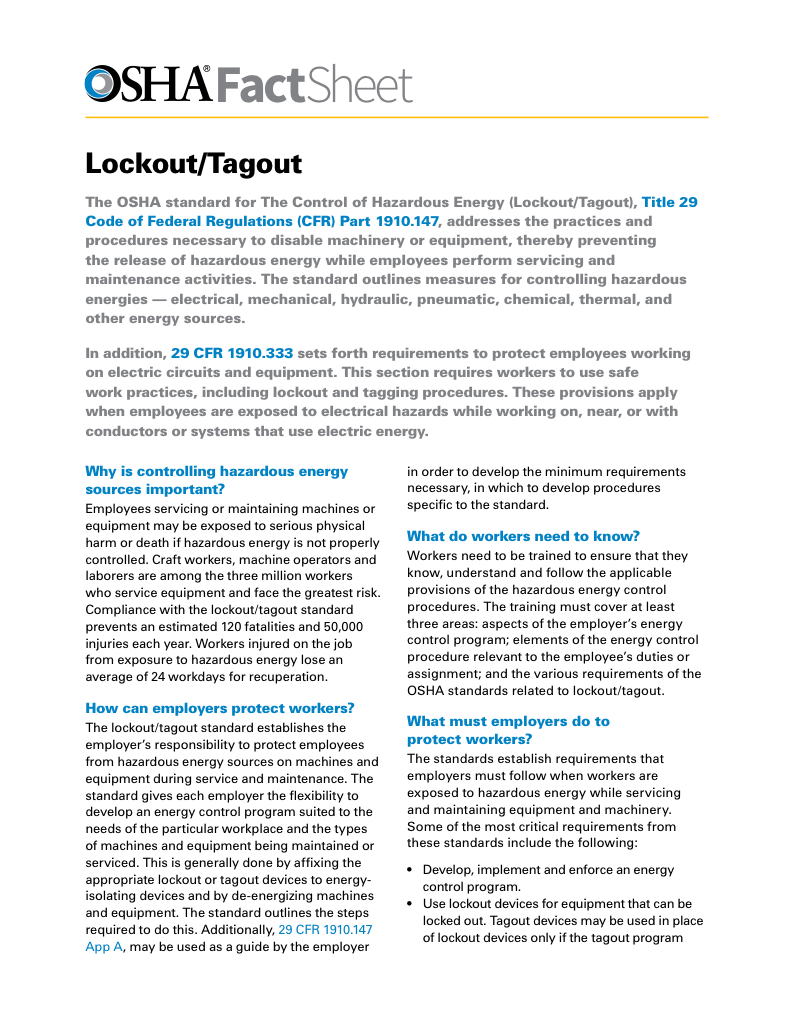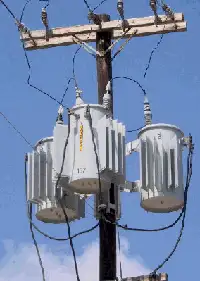OSHA Lockout Tagout Standard Explained

NFPA 70e Training
Our customized live online or in‑person group training can be delivered to your staff at your location.

- Live Online
- 6 hours Instructor-led
- Group Training Available
Download Our OSHA FS3529 Fact Sheet – Lockout/Tagout Safety Procedures

- Learn how to disable machines and isolate energy sources safely
- Follow OSHA guidelines for developing energy control programs
- Protect workers with proper lockout devices and annual inspections
The OSHA lockout tagout standard protects workers by controlling hazardous energy during equipment servicing. This safety regulation ensures proper shutdown, isolation, and secure tagging to prevent accidental startup and electrical accidents.
What is the OSHA Lockout Tagout Standard?
The OSHA lockout tagout standard (29 CFR 1910.147) defines procedures to control hazardous energy during maintenance.
✅ Requires isolating electrical, mechanical, and hydraulic energy sources
✅ Mandates locks, tags, and verification steps for worker protection
✅ Ensures compliance with federal safety standards and reduces accidents
The OSHA Lockout Tagout Standard, formerly 29 CFR 1910.147, outlines the legal requirements for controlling hazardous energy while servicing and maintaining machinery and equipment. This document is critical in preventing workplace injuries caused by the unexpected energization, startup, or release of stored energy. If you’re new to the concept, see What is Lockout Tagout? to understand the fundamentals and how they apply in industry.
Request a Free Training Quotation
It applies to a wide range of energy sources, including electrical, mechanical, hydraulic, pneumatic, chemical, and thermal systems. Employers must develop and enforce an energy control program that includes training for authorized employees, proper use of LOTO devices, and periodic inspections to ensure ongoing compliance with safety regulations. Understanding and implementing the OSHA Lockout Tagout Standard is essential for maintaining electrical safety and protecting workers across industrial settings. Read this page for more detailed information about OSHA Lockout Tagout Requirements.
The Occupational Safety and Health Administration (OSHA) established 29 CFR 1910.147 to protect workers who service or maintain machines or equipment capable of hazardous energy, specifically through the use of LOTO. The regulation requires employers to develop energy control programs that ensure all servicing activities are performed safely and in accordance with established guidelines. These programs must include clearly defined practices and procedures for shutting down, isolating, and securing hazardous energy sources to prevent unexpected startup or the release of hazardous energy during servicing and maintenance. Our OSHA Lockout Tagout Page gives a general overview of the administration's overall objectives.
Sign Up for Electricity Forum’s Arc Flash Newsletter
Stay informed with our FREE Arc Flash Newsletter — get the latest news, breakthrough technologies, and expert insights, delivered straight to your inbox.
To remain compliant, employers must ensure that workers are trained to recognize hazardous energy risks and understand how to properly apply LOTO devices to disable machinery before servicing begins. The rules apply to a variety of energy sources, including electrical, mechanical, hydraulic, and pneumatic systems. Without proper practices and procedures, the failure to isolate energy sources could result in severe injury or death. OSHA mandates that each piece of equipment has a written procedure to ensure consistency and safety when working with machines or equipment that pose potential energy hazards.
The official OSHA regulation for Lockout Tagout is:
29 CFR 1910.147 – The Control of Hazardous Energy (Lockout/Tagout)
This page provides the full text of the regulation, including definitions, scope, application, procedures, training, and enforcement requirements. Workers can gain essential skills through OSHA Lockout Tagout Training, designed to meet federal safety expectations.
Energy Control Programs: Core of the OSHA Standard
Under this regulation, employers must develop and implement a documented energy control program. This program must include specific procedures for shutting down and isolating equipment, applying LOTO devices, and verifying that energy has been effectively controlled before work begins. The purpose is to ensure that workers are never exposed to uncontrolled hazardous energy during routine or non-routine service.
Authorized vs Affected Employees
A key distinction in the OSHA Lockout Tagout Standard is the designation of authorized employees—those who apply and remove LOTO devices—and affected employees—those who operate or use the equipment being serviced. OSHA mandates that each group receive appropriate training tailored to their responsibilities. Refresher training and periodic audits are also required to ensure the effectiveness of the overall program. Every facility needs a documented Lockout Tagout Program to integrate policy, procedures, and training into daily operations.
Types of Hazardous Energy Covered by OSHA
The rules in energy lockout tagout 29 cfr 1910.147 recognize various forms of hazardous energy, including electrical, mechanical, hydraulic, pneumatic, chemical, and thermal. It applies wherever energy could be unexpectedly released during maintenance tasks. Lockout (the placement of a physical locking device) is the preferred method of control. LOTO may only be used if the equipment cannot be locked out, and only with additional protective measures.
Documentation and Inspection Requirements
Importantly, OSHA’s regulation emphasizes documentation and enforcement. Employers must maintain written procedures for each piece of equipment or system where energy control is necessary. Additionally, an annual inspection of both the procedures and the performance of authorized employees is required. Noncompliance can result in significant penalties, including OSHA citations and fines. Hands-on application is reinforced through Lockout Tagout Practice, where procedures are tested in real scenarios. Step-by-step guidance is covered in our Lockout Tagout Procedure, outlining how to properly shut down, isolate, and secure equipment.
Who Must Comply with the OSHA LOTO Standard?
The LOTO Standard is not limited to the manufacturing industry. It also applies to construction, utility maintenance, and even service industries for machinery and electrical systems. Although the regulation provides a federal baseline, some U.S. states with their own OSHA-approved plans may impose more stringent requirements. Canadian employers often align with CSA Z460, but the principles of energy control are consistent across both jurisdictions.
Complying with the LOTO Standard is not optional for any organization with energized equipment; it’s a critical part of a safe and legally compliant workplace. Establishing a robust LOTO program reduces risk, ensures regulatory compliance, and reinforces a safety culture that protects workers and operational integrity. When several employees are involved, Group Lockout Tagout provides a method to protect everyone working on shared equipment.
Test Your Knowledge About Arc Flash!
Think you know Arc Flash? Take our quick, interactive quiz and test your knowledge in minutes.
- Instantly see your results and score
- Identify strengths and areas for improvement
- Challenge yourself on real-world electrical topics
Related Articles
-
To clear up common issues, explore Lockout Tagout Questions, where frequently asked topics are explained in detail.
To ensure compliance and worker protection, The Electricity Forum offers specialized Construction Electrical Safety Training, including NFPA 70E Training and CSA Z462 Arc Flash Training courses. Request a free training quotation today to equip your team with the knowledge and skills they need to stay safe on the job.








